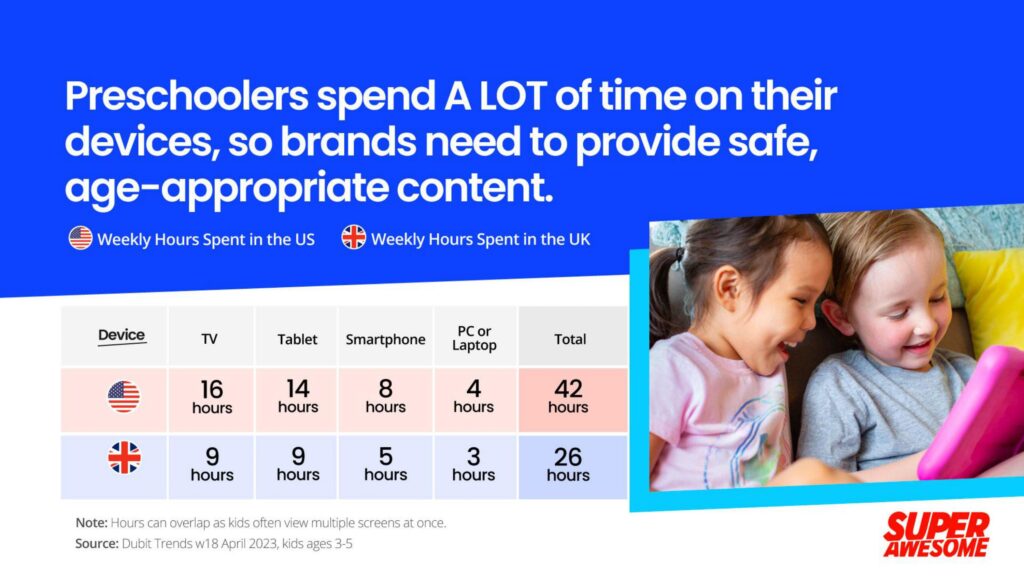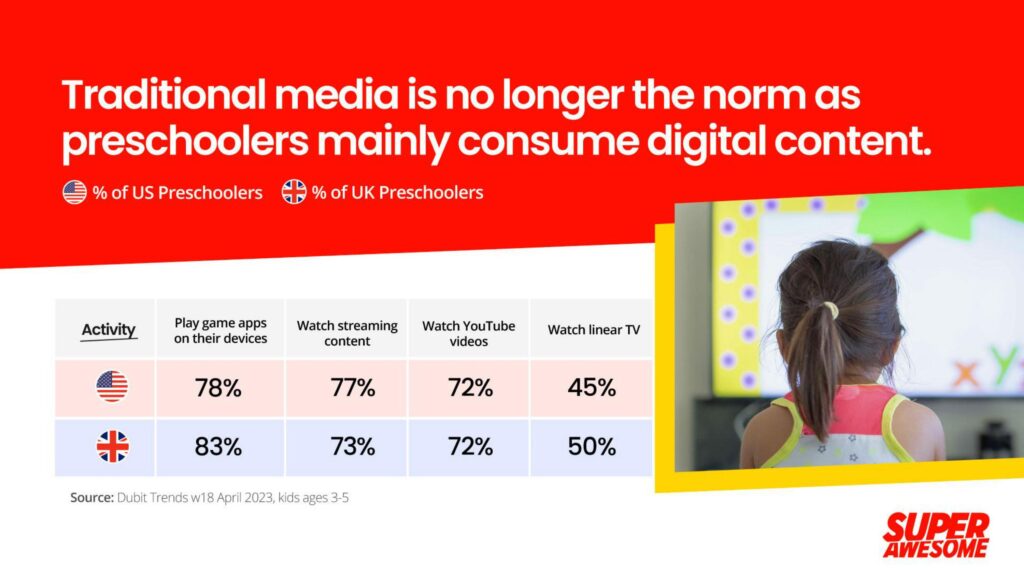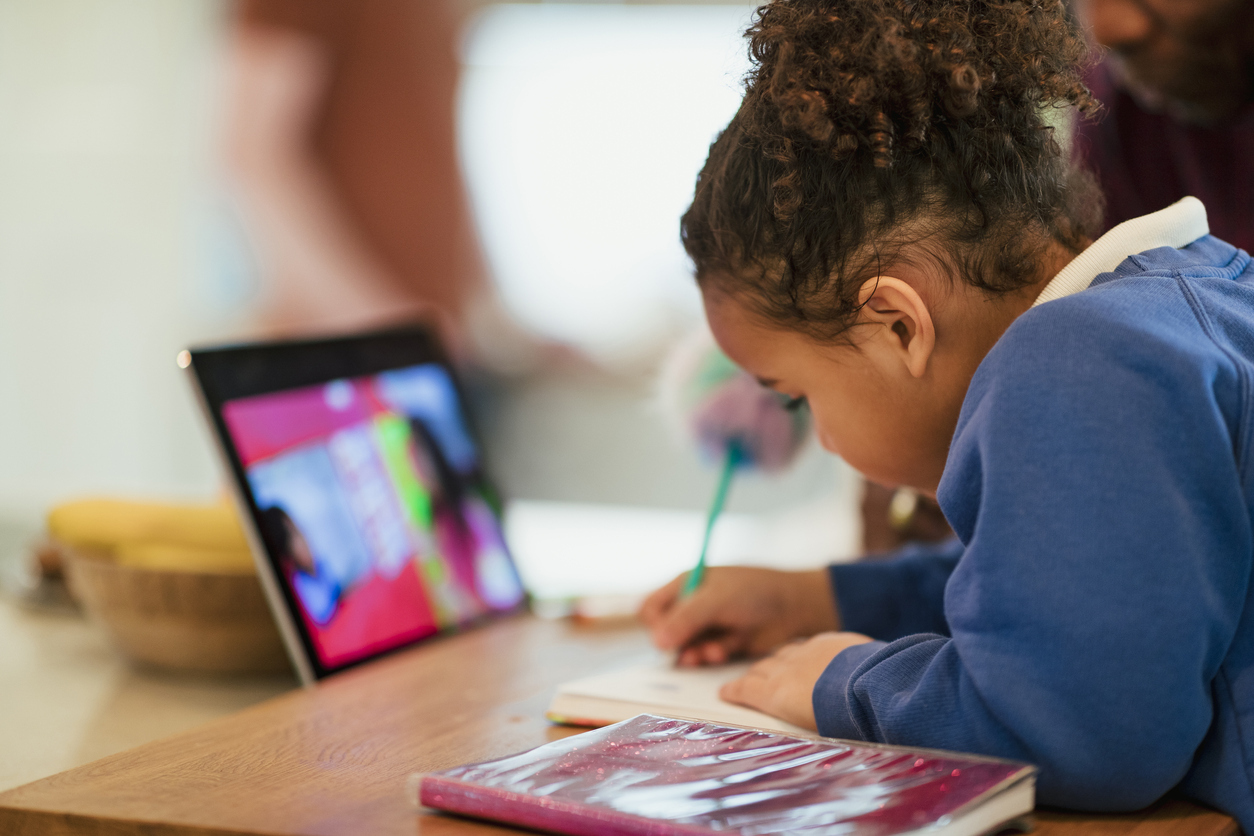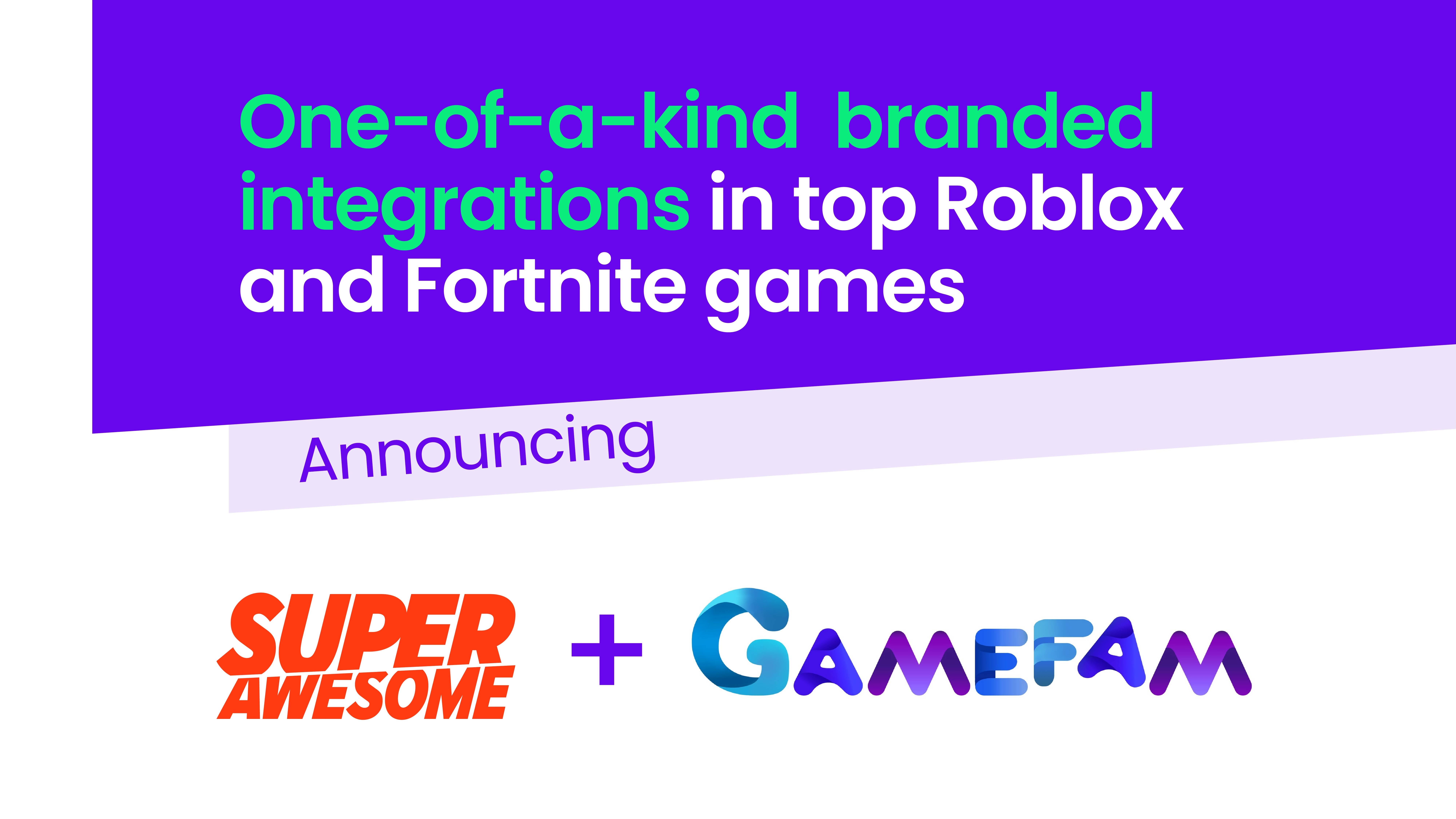Pre-school brands are navigating a new era, one where the influence of tech-savvy youngsters extends beyond mere toy preferences, impacting entire family purchasing decisions. SuperAwesome’s new research found that a whopping 95% of parents acknowledge their pre-schoolers’ influence on what they buy for them, and 85% say they impact what they purchase for the whole family.1
If brands only speak to parents, they’re overlooking a key opportunity to engage their influential kids as well. Crafting a safe, responsible strategy that resonates with pre-schoolers requires catering to the shared viewing experiences of parents and their children.
Regional Context: This content pulls from US and UK studies of 3-6-year-olds. Data specific to these regions has been highlighted.
Meet the Pre-school Audience
Picture being 3 to 6 years old today. Current pre-schoolers are still curious, imaginative, and playful, but growing up with gadgets in their hands has also made them more adaptable, connected, and selective in their preferences and choices.1
These young digital natives shape their preferences and choices early on, with a staggering percentage already immersed in technology.
In the US, a massive 83% of parents say their pre-schoolers are using tablets, with a majority also using smartphones (59%) and streaming devices (54%). In the UK, parents say tablets are still the top device (47%), with pre-schoolers also directly using streaming devices (46%) and smartphones (37%).

Pre-schoolers are spending a significant amount of time on their devices, emphasizing the importance of delivering safe, appropriate, and positive ad experiences that put kids’ well-being first.
In the US, parents say their pre-schoolers spend 30 hours a week watching content on TV or tablets, 8 hours on smartphones, and 4 hours on laptops/PCs.
UK kids are clocking in a lesser (but still significant) amount of screen time—a total of 18 hours on TV or tablets, and 8 on smartphones or laptops/PCs.
(Note: Hours can overlap as kids often view multiple screens at once.)

The landscape has shifted from traditional media to digital platforms, where over 70% of US and UK pre-schoolers engage with games, streaming content, and YouTube videos. Only about half watch linear TV.

Pre-schoolers Exert Significant Influence over Family Purchases, a Fact Not to Be Underestimated by Brands
Pre-schoolers aren’t shy about making their wishes known. They “very often” or “always” have a say in everything from the toys they want (82%) to the clothes they wear (68%).1
And for parents, making their kids happy is top of the list, with 72% putting their children’s wants and needs ahead of other expenses.1
From toys to everyday essentials, their preferences play a crucial role in parental decision-making. In fact, just two requests from their pre-schoolers is enough to influence parents’ purchases.1
Screen Time Is Now Family Time: Your Pre-school-Directed Digital Content Should Also Resonate with Family Co-viewing Audiences
Screen time IS family time, and it’s prime time for brands to reach a co-viewing audience of both children and parents. Families watch YouTube cartoons, kids’ shows, and influencer content together through their smart TVs4, and parents are 2.5x more likely to buy something they’ve seen advertised during these cozy moments with their pre-schoolers.5
We’ve seen this strategy produce amazing results, with one leading toy brand-boosting its purchase intent by 10% when both kids and parents saw a video ad.3
Four Effective Tactics to Incorporate into Your Family Co-viewing Strategy
Brands can’t rely on traditional media alone for their family co-viewing strategy. Here are four digital-first tactics to incorporate into your strategy:
1. Fine-Tune Your YouTube Strategy
70% of pre-schoolers remember toy ads they’ve seen in the past three months, and 74% asked their parents to buy what they saw.1
YouTube is the #1 place pre-schoolers notice these ads1, and millions of them watch YouTube Kids and YouTube Main with their families every day. But it’s hard to reach them with compliance, scale, and accuracy using Google’s tools alone.
AwesomeAds for Social reaches co-viewing audiences on YouTube with a far better on-target percentage than Google Direct, using SuperAwesome’s depth of contextual segments and human-reviewed YouTube channels to protect against inappropriate content.
2. Scale YouTube Videos Off-Platform to Reach Additional Family Co-viewing Audiences
Brands can broaden their YouTube videos’ reach across platforms like OTT, social media, and gaming by repurposing content for interactive, rich media campaigns. SuperAwesome’s AwesomeAds Marketplace is the largest digital youth content marketplace in the world, reaching over 37% of kids 3-5 years olds across mobile apps, OTT/VOD, and web.
Our insights also show that the engaging features and functionality of developmentally appropriate video ads help kids understand the play experience without seeing it in person and increase their excitement about your product.
A popular toy brand saw a +55% view-through-rate and +15% click-through-rate after pairing AwesomeAds for Social with an immersive media campaign available through AwesomeAds Marketplace.3
Ads are not only noticed, they are driving the all-important parental request. Our insights show that 69% of kids remember seeing ads for toys, collectibles, and board games in the past three months, and 80% of kids asked their parents to buy the thing they saw after seeing an ad for a toy.7
3. Partner with Family Creators to Produce Authentic Content on Social Platforms
In fact, 45% of pre-schoolers watch influencer content with their parents on YouTube6 and 54% of US parents follow the same influencers as their kids8. This is a great opportunity to hit all angles of the co-viewing spectrum by creating content with family creators. Our influencer marketing solution, SuperAwesome Creators, strengthens this approach by connecting brands with trusted, pre-vetted youth, family, and gaming influencers to create fun and authentic video content that scales.
4. Design Campaigns That Pre-schoolers and Their Parents Understand and Enjoy
Last but definitely not least, when we’re talking ads for co-viewing audiences, you want to please parents and kids—keeping it short, and understandable is key, as brands aim to create a safe and respectful advertising environment. This approach not only engages the young viewers but, more importantly, also earns the trust and approval of parents, making them more inclined to support the brand.
Having worked on nearly 11,000 media campaigns, we’ve learned that brief video ads work best for preschoolers’ attention spans. Rich media minigames like memory, pairing, drag and drop, and search-in-scene both satisfy preschoolers’ curious natures and let them and their parents explore your brand on their terms. Make sure they can easily exit if they want to, and establish a clear line between what’s an ad and what’s their regular content.
If you’d like to learn more about creating your own pre-school strategy, get in touch!
(1) Family Influence Tracker, kids ages 4-6, Q4 2023 US & UK
(2) Dubit Trends w18 April 2023, kids ages 3-5
(3) Internal SuperAwesome campaign data
(4) SuperAwesome OnePulse survey, parents of kids ages 2-5s
(5) Paramount Study: When Families Watch TV Together, Marketers Win
(6)SuperAwesome OnePulse bespoke survey. Q. What type of content do you watch together on YouTube? Base: Parents of 2-5s (150)
(7) SuperAwesome’s proprietary Cost of Living Tracker 2023. Q. Please select for which of these types of products/services you have seen ads in the past 3 months. Q. What did you do after seeing these ads? Base: 4-6 (212).
(8) SuperAwesome’s “Understanding Influencers 2021 SA Creators Playbook” Q2.8. Do you and your child follow any of the same influencers? BASE: All parents following at least one social media Influencer– US = 613



